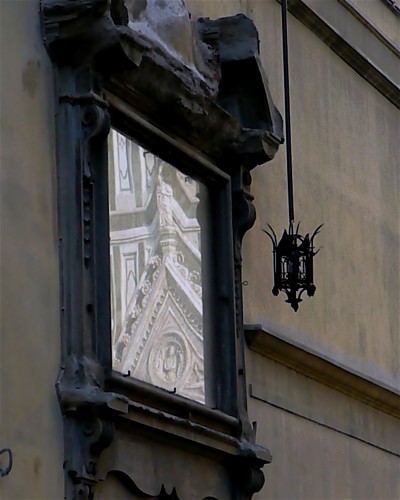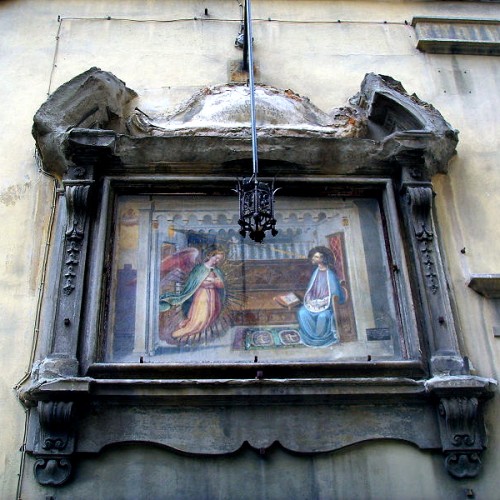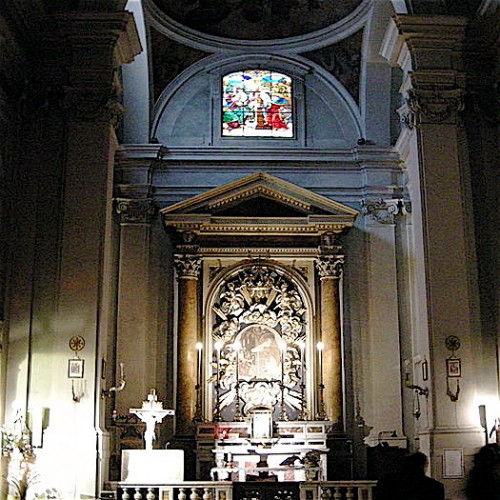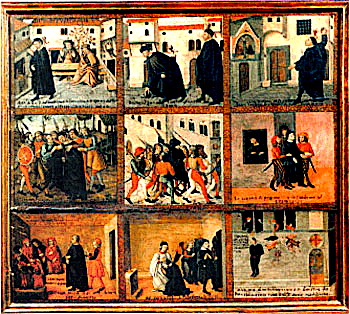One thing that continues to fascinate me about Florence, despite all of its many frustrating aspects, is how nuggets of historical gold can be found once you learn one little fact – kind of a Medieval/Renaissance version of “Six Degrees of Separation.”
For example: I visited the Chapter Library in Piazza del Capitolo. Across the piazza was a tabernacle on the wall. I took an arty reflective photo of it because the glass was too dirty to get a good shot of the fresco inside.

As I was researching the history of the Biblioteca Capitolare, the ancient library, I ran across a reference to the tabernacle, which led to the following story and more places to visit (just click on the embedded links):
On a hot summer night in 1501, a young man named Antonio Rinaldeschi, drunk and angry at losing his money and some of his clothes while gambling at the Osteria del Fico in what is now Via del Giglio staggered through the streets around the Cathedral cursing the name of the Virgin. He entered the tiny piazza in front of the small church, which is now the Chapter Library. There on a wall he noticed a tabernacle with an Annunciation known as the Madonna or Santa Maria de’Ricci (probably commissioned by the Ricci family who lived in the area). He stooped, gathered up a handful of horse manure and threw it at the face of the Virgin before running away. Unfortunately for Antonio, the dung did not dry and fall off (a clump stuck to her halo) and his act was witnessed by a boy, who was able to describe the defiler. The Archbishop came to view the outrage and the devoted came to pray and leave votive candles.

The Otto di Guardia, eight men charged with keeping the peace, were commissioned to find the culprit. Rinaldeschi was soon identified as a likely suspect. He was taken into custody in the garden of the convent of S. Francesco al Monte alle Croci (behind the Church of San Salvatore), outside the city walls. Fearing the mob, he tried to commit suicide by stabbing himself in the chest, but was saved by hitting a rib. He was imprisoned in the Bargello, charged with gambling, blasphemy and attempted suicide. Although these were not usually offenses that called for the death penalty, Antonio reportedly asked to be executed for fear of worse treatment by a lynch mob, which had been fired up by the radical monk Savonarola. Rinaldeschi was hanged from the wall of the Bargello.

Today the shrine is replaced by a copy. The original was placed on the altar of the church of Santa Maria de’Ricci. The whole story of Antonio Renaldeschi appears painted in tempera on a board divided into nine squares, which show the true sequence of events. The board is now in the Stibbert Museum.

Doomed Antonio’s story is described and discussed at length in Sacrilege and Redemption in Renaissance Florence. The slender book by W.J. Connell and G. Constable unveils a series of newly discovered sources concerning this striking episode. The authors show how the political and religious context of Renaissance Florence resulted both in Rinaldeschi’s death sentence and in the creation by Savonarola’s followers of a new religious devotion in the heart of the city commemorating the event.
Another historical thread led out of the Piazza del Capitolo, but that will be the subject of a future post.
